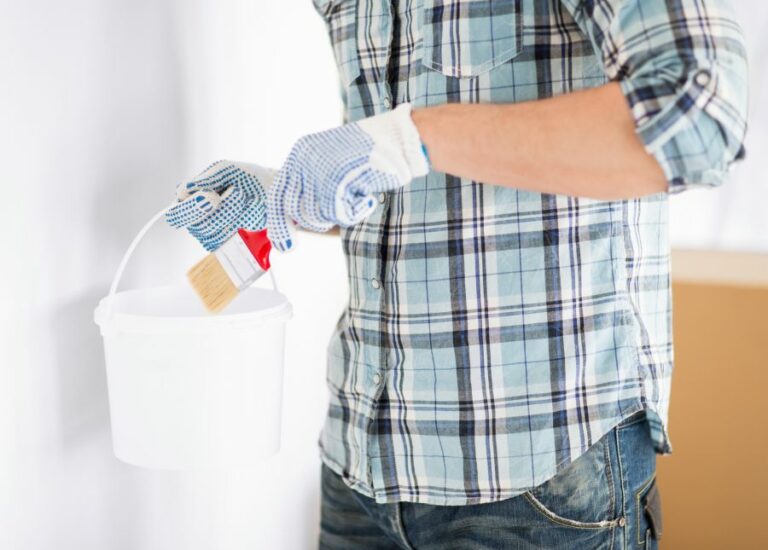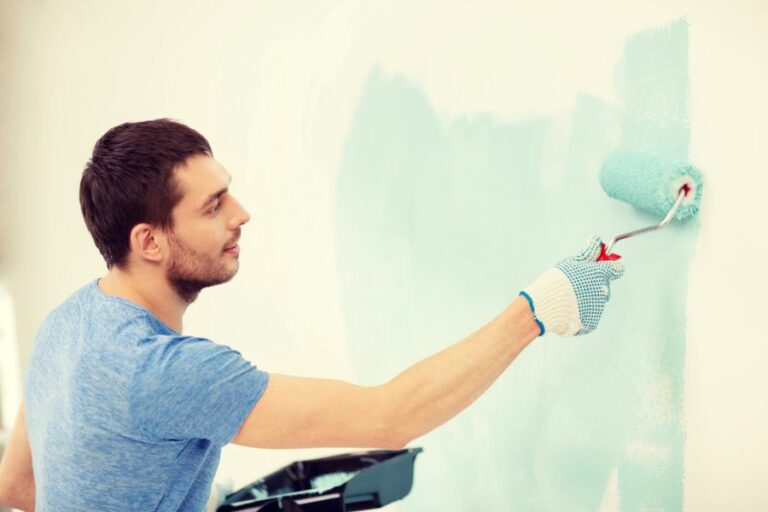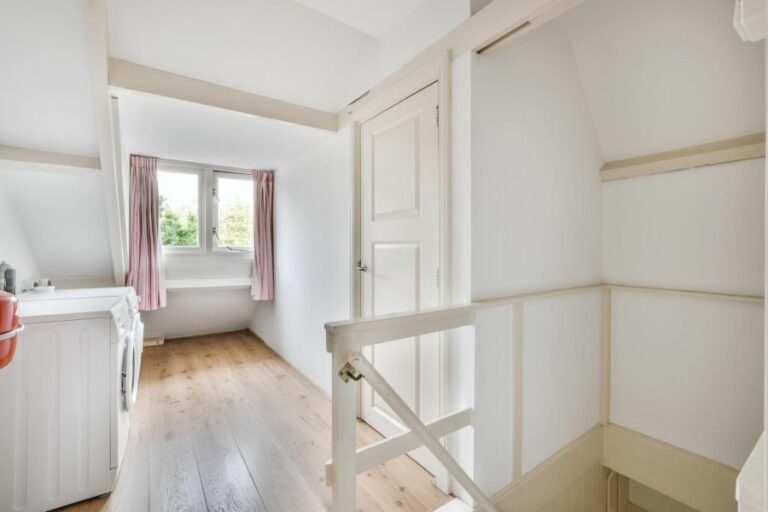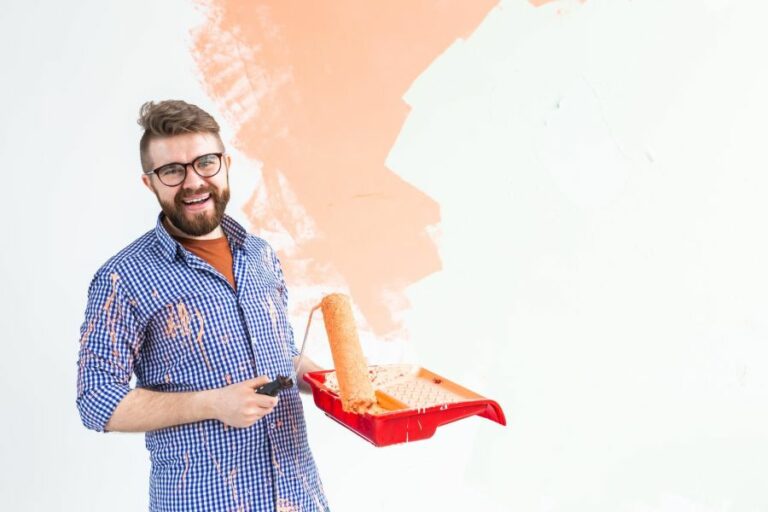Prepping Indoor Surfaces For Painting, 25 Things You Should Know
Are you planning to refresh your home with a new coat of paint but unsure where to start? Don’t worry; we’ve got you covered. Prepping indoor surfaces for painting is the key to achieving that professional, smooth finish that every homeowner desires. As experts in the field, we are more than happy to share our knowledge and provide you with a step-by-step guide to properly prepare your walls properly, ensuring a successful and long-lasting paint job.
Prepping indoor surfaces for painting:
Prepping indoor surfaces for painting involves assessing surface condition, cleaning (removing dirt, dust, grease, and mold), repairing damaged areas (patching holes, cracks, dents, and gouges, resetting popped nail heads), and sanding and priming. Proper preparation ensures a smooth, durable, and long-lasting paint job.

Ready to give your indoor spaces a fresh new look? Learn about the ins and outs of preparing surfaces for a seamless paint job, from cleaning and repairs to priming and sanding. Read on for all the best tips and tricks in ensuring an impeccable finish!
Contents
- 1 Indoor Surface Preparation for Painting: A Guide
- 2 Interior Surface Preparation: Steps for Painting Success
- 3 Essential Pre-Painting Prep Work: What You Need to Know
- 3.1 • Assessing the Surface
- 3.2 • Cleaning the Surface
- 3.3 • Removing Wallpaper or Peeling Paint
- 3.4 • Repairing Cracks and Holes
- 3.5 • Sanding the Surface
- 3.6 • Priming the Surface
- 3.7 • Masking and Protecting Areas
- 3.8 • Choosing the Right Paint and Tools
- 3.9 • Storing and Disposing of Materials
- 3.10 • Safety Precautions
- 4 Optimal Cleaning Solutions for Pre-Painting Surfaces
Indoor Surface Preparation for Painting: A Guide
• Importance of Surface Preparation
Proper surface preparation is crucial for achieving a smooth, durable, and long-lasting paint job. Inadequate prep work can lead to paint failure, such as peeling, flaking, or blistering. To ensure that your new paint adheres well and looks its best, follow these steps for prepping indoor surfaces.
• Assessing the Surface Condition
Before beginning any prep work, it’s essential to assess the surface you’ll be painting. This will help you determine the appropriate cleaning methods and materials. Pay close attention to:
- Cracks and holes: These should be filled with a suitable filler or spackling compound.
- Loose paint: Scrape off loose or peeling paint with a paint scraper.
- Grease and dirt: Clean these areas thoroughly to ensure proper paint adhesion.
• Cleaning the Surface
Cleaning the surface is an essential step in preparing it for painting. Grease, dirt, dust, and other contaminants can interfere with paint adhesion, leading to uneven results and a shorter lifespan for the paint job.
– Removing Dirt and Dust
Begin by dusting the surface with a soft-bristle brush or a microfiber cloth. This will help remove any loose dust or debris from the area. For more stubborn dirt, use a mild detergent and water solution, applying it with a sponge or cloth. Rinse with clean water and allow the surface to dry completely before proceeding.
– Degreasing the Surface
Greasy surfaces, such as kitchen walls, should be cleaned using a degreasing agent. This will remove any oil-based contaminants that might interfere with the paint’s ability to adhere to the surface. Follow the manufacturer’s instructions, and be sure to wear protective gloves and eyewear as these products can be harsh on your skin and eyes.
– Cleaning Mold or Mildew
If you encounter mold or mildew on the surface, it’s essential to properly clean it before painting. The Environmental Protection Agency suggests using a solution of one part bleach and three parts water to clean mildew. Allow the solution to sit on the surface for a few minutes, then scrub with a soft brush, rinse with clean water, and let the surface dry completely.
• Repairing Damaged Areas
Once the surface is clean, it’s time to address any cracks, holes, or other damage that may be present.
– Patching Holes and Cracks
Use a putty knife to apply a suitable patching compound, such as spackling paste, to any holes or cracks in the surface. Smooth the compound to create an even surface, feathering the edges so that the patch blends seamlessly with the surrounding area. Once the patching compound has dried, use fine-grit sandpaper (around 150-grit) to lightly sand the patched areas, creating a smooth, even finish.
– Fixing Dents and Gouges
For larger dents and gouges, it may be necessary to use a more robust filler, such as a two-part epoxy. Mix the epoxy according to the manufacturer’s instructions, and apply it to the damaged area with a putty knife. Similar to patching holes, make sure to feather the edges for smooth blending. Allow the epoxy to cure before sanding with fine-grit sandpaper.
– Resetting Popped Nail Heads
Over time, nails can begin to back out of the wall, creating small protrusions. To fix this issue, use a hammer and a nail set to gently tap the nail head below the surface of the wall. Fill the resulting hole with spackling paste, sand smooth, and repeat the process for any other popped nail heads.
• Sanding and Priming
After repairing any damaged areas, the final steps in prepping the surface involve sanding and priming.
– Sanding
Sanding the entire surface with fine-grit sandpaper will help promote better paint adhesion and create a smoother base. Be sure to sand in the direction of any natural texture, such as wood grain or plaster marks. Use a sanding block or pad for even pressure and consistent results. After sanding, vacuum or wipe down the surface to remove any dust.
– Priming
Primer creates a uniform surface for the paint to bond to, allowing for better adhesion and a longer-lasting finish. Depending on the surface and the type of paint you’re using, you may need to use a specific type of primer. Be sure to consult the paint manufacturer’s recommendations.
Apply the primer using a roller or brush, following the manufacturer’s instructions for drying times. Once the primer is completely dry, lightly sand the surface one more time with fine-grit sandpaper. This will help ensure a smooth and even finish when you apply the paint.
• Conclusion
Proper surface preparation is key to a successful paint job. By taking the time to clean, repair, and prime your indoor surfaces, you’ll help ensure a smooth, durable, and long-lasting finish. The final result will be worth the effort, and your newly painted surface will look fantastic for years to come.
Interior Surface Preparation: Steps for Painting Success
Painting your home can give it a fresh, new look, but the success of your project largely depends on the preparation. Properly preparing interior surfaces for painting can help ensure a smooth, long-lasting finish.
• Step 1: Clear the Area
Before you begin work, remove all furniture, wall hangings, and other objects from the area. If you cannot move some large or heavy items, cover them with drop cloths or plastic sheets to protect them from paint splatters.
• Step 2: Clean the Surface
One of the most critical steps in preparing your walls for painting is cleaning the surface. Dust, dirt, and grease can affect the adhesion of the paint, leading to ugly peeling and poor finish.
– Washing the Walls
Use a mild detergent solution and a sponge or cloth to scrub the walls. Make sure to rinse the surface thoroughly with clean water to remove any soap residue.
Tip:
For particularly greasy areas, like kitchen walls, you can use trisodium phosphate (TSP) solution to remove stubborn grease.
The US Department of Agriculture suggests using one cup of TSP mixed with four gallons of water for general cleaning purposes. Always wear gloves and eye protection when working with TSP.
– Cleaning Mold or Mildew
If you discover mold or mildew on the surface, mix a solution of one part bleach to four parts water and gently scrub the affected area. Rinse thoroughly and allow the surface to dry completely.
• Step 3: Repair Surface Damage
Inspect the surface for any damage, such as cracks, holes, or dents. Repair these issues before painting to achieve a smoother finish.
– Patching Holes or Small Dents
Fill any small holes or dents with a pre-mixed patching compound or spackling paste using a putty knife. Allow the compound to dry according to the manufacturer’s instructions, then sand the area smoothly using fine-grit sandpaper. Wipe away any dust with a damp cloth.
– Repairing Cracks
For larger cracks or damages, use a joint compound or plaster to repair the area. Apply a thin layer of compound, pressing it into the crack using a putty knife. Allow the compound to dry, then sand the area smoothly.
You may need to apply multiple layers, allowing each layer to dry and be sanded smooth before proceeding.
• Step 4: Sanding the Surface
Sanding is an essential step to ensure proper adhesion of the paint, especially for glossy surfaces. Use fine-grit sandpaper (150-220 grit) to lightly sand the entire surface, including the repaired areas. Make sure to wear a dust mask and safety goggles while sanding.
Once you have finished sanding, use a vacuum or damp cloth to remove any dust.
• Step 5: Apply a Primer
Priming the surface is crucial for achieving an even, professional finish. A primer helps the paint adhere better, minimizes surface imperfections, and can even save you money by reducing the number of paint coats needed.
– Choosing a Primer
Select a primer based on your surface material and the type of paint you plan to use. For example, a latex-based primer works well with latex paint, while an oil-based primer is suitable for oil-based paints.
– Applying the Primer
Mix the primer well, and apply it using a brush, roller, or paint sprayer, depending on the size of the area and your personal preference. Allow the primer to dry according to the manufacturer’s instructions before painting.
• Step 6: Protect Adjacent Areas
To avoid accidentally painting other surfaces, such as trim, windows, and ceilings, use painter’s tape to mask off adjacent areas. Press the tape firmly to ensure a tight seal, preventing paint from seeping underneath.
• Step 7: Paint the Surface
Now that the surface is clean, repaired, and primed, you’re ready to paint. Choose a high-quality paint and apply it according to the manufacturer’s instructions using a brush, roller, or paint sprayer.
By following these essential steps, you can ensure a successful outcome for your interior painting project. Proper preparation not only helps you achieve a smooth and professional finish but also extends the lifespan of your paint job.
So, invest the time and effort needed to prepare your interior surfaces and enjoy the results of a beautifully painted home.
Step | Description |
|---|---|
1 | Clear the room: Remove all furniture, decorations, and other loose items from the room to create a clean workspace. |
2 | Protect the floor: Lay down drop cloths, plastic sheeting, or old newspapers to protect your flooring from paint splatters. |
3 | Clean the walls: Use a sponge and mild detergent to clean the walls and remove any dirt, dust, or grease that could affect paint adhesion. |
4 | Repair damages: Fill in any cracks or holes with spackle or fillers, and sand down any rough or uneven surfaces for a smooth finish. |
5 | Remove or mask hardware: Remove any outlets, switch plates, or other hardware from the walls, or use painter’s tape to mask them off if they cannot be removed. |
6 | Tape off edges: Apply painter’s tape along the edges of the walls, ceiling, trim, and adjacent surfaces to ensure clean lines when painting. |
7 | Prime the walls: Apply a coat of suitable primer to the walls to improve paint adhesion and ensure an even, consistent paint finish. |
Essential Pre-Painting Prep Work: What You Need to Know
Before applying a fresh coat of paint, it’s essential to properly prepare the surface to ensure a smooth, long-lasting finish.
• Assessing the Surface
First, carefully examine the surface to determine what type of preparations are required. Look for any cracks, peeling paint, mold, or other imperfections that need to be addressed before painting begins. Based on your assessment, make a list of needed materials and tools for the job.
• Cleaning the Surface
Remove all dirt, dust, and debris from the surface to be painted. If necessary, use a mild detergent and water solution to gently scrub away stubborn grime. A clean surface ensures proper adhesion of the new paint.
• Removing Wallpaper or Peeling Paint
If working with a surface that has old wallpaper or peeling paint, it’s essential to remove these layers before applying a fresh coat of paint. Use a wallpaper steamer or chemical stripper to loosen the material, followed by a scraper to remove it. Be careful not to damage the underlying surface.
• Repairing Cracks and Holes
If you find any cracks, holes, or imperfections, patch them using a pre-made patching compound or by mixing your own with water and a patching powder. Smooth the repaired area with a putty knife and let it dry completely. For larger repairs, it’s recommended to use joint compound and mesh tape.
• Sanding the Surface
Once all repairs are complete, it’s time to sand the surface. Sanding not only smooths out any imperfections but also helps the paint adhere better. Use fine-grain sandpaper and work in a circular motion. Be sure to wear a dust mask and safety goggles to protect yourself from dust particles.
• Priming the Surface
One of the most critical steps in preparing a surface for painting is applying a primer. Primers help seal the surface and provide a solid base for the paint to adhere to. Choose a primer designed for your specific surface type and apply it evenly with a brush or roller.
Let the primer dry completely, as recommended by the manufacturer, before moving on to the next step.
• Masking and Protecting Areas
Once the primer is dry, protect any edges, trim, or fixtures you don’t want to be painted by using painter’s tape. Press the tape firmly to the surface to ensure a clean, crisp paint line. Also, cover any floors or furniture in the area with drop cloths to catch any paint drips.
• Choosing the Right Paint and Tools
Select a high-quality paint appropriate for your surface and desired finish. Ensure you have enough paint to cover the entire area, typically calculated by square footage.
Additionally, gather the necessary tools, such as brushes, rollers, paint trays, and extension poles, to make the application process smooth and efficient.
• Storing and Disposing of Materials
Store any unused paint, tools, and materials in a safe and dry place for future projects. Dispose of any hazardous waste, such as paint thinners or solvents, according to your local guidelines. Consider donating unused paint to a local school, community organization, or recycling center.
• Safety Precautions
Throughout the entire preparation process, ensure you are taking necessary safety precautions. Wear gloves, masks, and goggles when needed, and work in a well-ventilated area to minimize exposure to fumes.
In conclusion, thorough preparation is crucial for a successful paint job. By following these steps and taking the time to properly prepare the surface, you’ll be on your way to a beautiful, durable, and long-lasting finish.
For more information on surface preparation, the Environmental Protection Agency provides helpful resources here.
Optimal Cleaning Solutions for Pre-Painting Surfaces
When preparing a surface for painting, it is crucial to ensure that the surface is properly cleaned and prepped to achieve a high-quality finish. By using the appropriate cleaner for the job, you not only avoid wasting time and resources, but it ensures the longevity of the painted surface.
• The Importance of Surface Preparation
Before diving into the best cleaners for surface preparation, it’s essential to understand the significance of this step in the painting process. Adequate surface preparation is critical for ensuring proper adhesion of the paint, preventing peeling, and achieving a smooth finish.
By taking the time to clean and prep your surface correctly, you not only save time and money in the long run but also improve the overall appearance of the final result.
• Basic Cleaners for Light Surface Prep
If you are merely dealing with light surface contamination like dust, dirt, or mild grime, basic home cleaners are usually sufficient. Most often, a simple mix of warm water and mild dish soap will be enough to clean the surface effectively.
A lightly dampened cloth or sponge can be used to apply the soapy mixture, followed by a clean water rinse and thorough drying. For more persistent grime or grease, a cleaner, such as trisodium phosphate (TSP), can be useful.
TSP is a heavy-duty cleaner that cuts through grease, stains, and residue, perfect for preparing surfaces for painting. It can be found at your local hardware store and must be mixed with water according to the manufacturer’s instructions.
• Specialized Cleaners for More Challenging Surfaces
In some cases, you may encounter surfaces with mold, mildew, or rust, which require specialized cleaners to ensure they are adequately prepared for painting.
– Mold and Mildew
When dealing with mold and mildew, it is crucial to not only clean the surface but also kill the spores to prevent them from returning. A bleach-based solution is recommended for this task.
You can create your own by mixing one-part bleach to three parts water, or you can purchase a commercial mold and mildew cleaner. Apply the solution to the affected area using a spray bottle or sponge, let it sit for 15-20 minutes, and then scrub with a stiff brush before rinsing and drying.
As a side note, it is crucial to take proper safety precautions by wearing gloves, goggles, and a mask when handling bleach.
– Rust
Rust removal requires both cleaning and eliminating rust from the surface. Preparing a rusty surface for painting involves using a wire brush or a power tool with a wire brush attachment, such as a drill, to remove the rust.
Once the rust has been scraped away, apply a commercial rust remover, following the manufacturer’s instructions. After treating with the rust remover, be sure to rinse and dry the surface thoroughly. In some cases, a rust-inhibitive primer may be needed to prevent future rust formation.
• Safety and Environmental Considerations
When using chemical-based cleaners, especially those containing harsh solvents, it’s essential to take proper safety precautions. This includes wearing personal protective equipment like gloves, goggles, and a mask, as well as working in a well-ventilated area to avoid inhaling fumes.
Additionally, be sure to dispose of any containers and clean waste according to local regulations, as some chemicals can pose environmental risks.
For those concerned about the environmental impact of their cleaning choices, searching for environmentally friendly or low VOC (Volatile Organic Compounds) cleaners is recommended.
• Final Tips for Surface Preparation Success
Aside from selecting the appropriate cleaner, there are some general tips that can help ensure your surface preparation is a success.
- Always give yourself ample time for the cleaning process. Rushing through this step can lead to subpar painting results.
- Be sure to clean the entire surface, even if it appears to be clean. Paint can often reveal underlying dirt and grime.
- Always test a small, inconspicuous area when using a new cleaner to ensure it won’t damage or discolor the surface.
- Following the manufacturer’s instructions carefully when using any cleaner, especially those with chemicals or solvents.
- Allow the surface to dry thoroughly before beginning to paint. Moisture trapped under the paint can cause bubbling, peeling, or a poor finish.
In summary, proper surface preparation is critical in achieving professional-level painting results. Choosing the appropriate cleaner, based on the specific surface and contaminant, ensures a clean and adherent foundation for paint application.
By following the advice outlined in this article and taking the time to thoroughly clean and prep surfaces, you can achieve a beautiful, lasting finish for your paint job.
For more information on surface preparation, visit the EPA’s guidelines on renovation, repair, and painting safety.
Method | Advantages | Tips & Recommendations |
|---|---|---|
Soap and water | Effective, simple, and affordable | Use a mild detergent, rinse thoroughly, and allow the surface to dry completely |
TSP cleaner (trisodium phosphate) | Removes grease, dirt, and heavy soiling; may help paint adhere better | Follow the product’s instructions, wear gloves, and rinse thoroughly |
Sanding | Smooths out imperfections and rough patches | Pick the right sandpaper grit for the surface and use a dust mask |
Deglosser | Removes gloss or shine from the surface to help paint adhere | Apply with a cloth or brush, follow the product’s instructions, and work in a well-ventilated area |
Vacuuming | Removes dust and debris | Use a brush or nozzle attachment and go over the surface after sanding or cleaning |
Tack cloth | Ensures the surface is dust-free | Wipe the surface gently after cleaning and sanding to remove any remaining dust |







